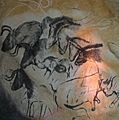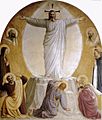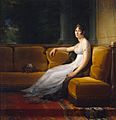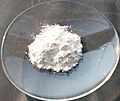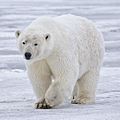White facts for kids
| This box shows the color white. |
|---|
White is a color. You can make white light by mixing all the other colors of the light spectrum together. These colors include red, orange, yellow, green, blue, indigo, and violet.
White is often connected with light, goodness, innocence, purity, and cleanliness. Many people think of white as the color of perfection. It's the opposite of black, and it usually has a positive meaning. White can also represent a fresh start or a successful beginning. In heraldry, which is the study of coats of arms, white stands for faith and purity.
In advertising, white often suggests coolness and cleanliness. This is because it's the color of snow. White can also show simplicity in high-tech products. It's a good color for charitable groups. For example, angels are often imagined wearing white clothes. White is also linked to hospitals, doctors, and cleanliness. This means it can be used to show safety when promoting medical products. White is often connected with low weight, low-fat food, and dairy products.
Images for kids
-
Image of Sirius A and Sirius B taken by the Hubble Space Telescope. Sirius B, a white dwarf, is the faint pinprick of light to the lower left of the much brighter Sirius A.
-
Prehistoric paintings in Chauvet Cave, France (30,000 to 32,000 BC)
-
Painting of the goddess Isis (1380–1385 BC). The priests of her cult wore white linen.
-
Statue of the chief Vestal Virgin, wearing a white palla and a white veil.
-
The monks of the order of Saint Benedict (circa 480–542) first dressed in undyed white or gray wool robes, here shown in painting by Sodoma on the life of Saint Benedict (1504). They later changed to black robes, the color of humility and penitence.
-
Under Pope Pius V (1504–1572), a former monk of the Dominican Order, white became the official color worn by the Pope.
-
The white lamb in the Ghent Altarpiece by Jan van Eyck. (1432)
-
The Transfiguration by Fra Angelico (1440–1442)
-
Mary Stuart wore white in mourning for her husband, King Francis II of France, who died in 1560.
-
White gown of Marie Antoinette, painted by Elisabeth Vigée-Lebrun in 1783.
-
President George Washington in a white powdered wig. The first five Presidents of the United States wore dark suits with powdered wigs for formal occasions.
-
Portrait of Joséphine de Beauharnais in a classic Empire gown, modeled after the clothing of ancient Rome. (1801), by François Gérard. (The State Hermitage Museum).
-
Symphony in White No. 1 – The White Girl, by James McNeill Whistler (1862).
-
Poster for the White Army during the Russian Civil War (1917–22). The poster says: "for a United Russia."
-
White light refracted in a prism revealing the color components.
-
The White Cliffs of Dover, made of limestone
-
Zinc white is made from zinc oxide. Zinc oxide is used in paints, suntan lotion, and some foods.
-
The dove is an international symbol of peace.
-
The Beluga whale lives in Arctic and sub-arctic waters, where its color is an effective camouflage
-
A Polar Bear in Alaska. Its color is a form of camouflage
-
Pope Francis at the Vatican. Popes have traditionally worn white since 1566.
-
The Buddhist deity Tara is often depicted with white skin.
-
The wedding dress of Queen Victoria (1840) set the fashion for wedding dresses of the Victorian era and for the 20th century.
-
The Barong Tagalog is a traditional folk costume of the Philippines; this attire is worn on formal gatherings and weddings.
-
Although the Parthenon in Athens (5th century BC) is white today, it was originally painted with many colors
-
The Cathedral of Milan (1386–1965)
-
Dutch Reformed Church interior in Delft, the Netherlands (16th century)
-
Interior of Old North Church, Boston (1723)
-
The White House (1801), Washington D.C.
See also
 In Spanish: Blanco para niños
In Spanish: Blanco para niños



